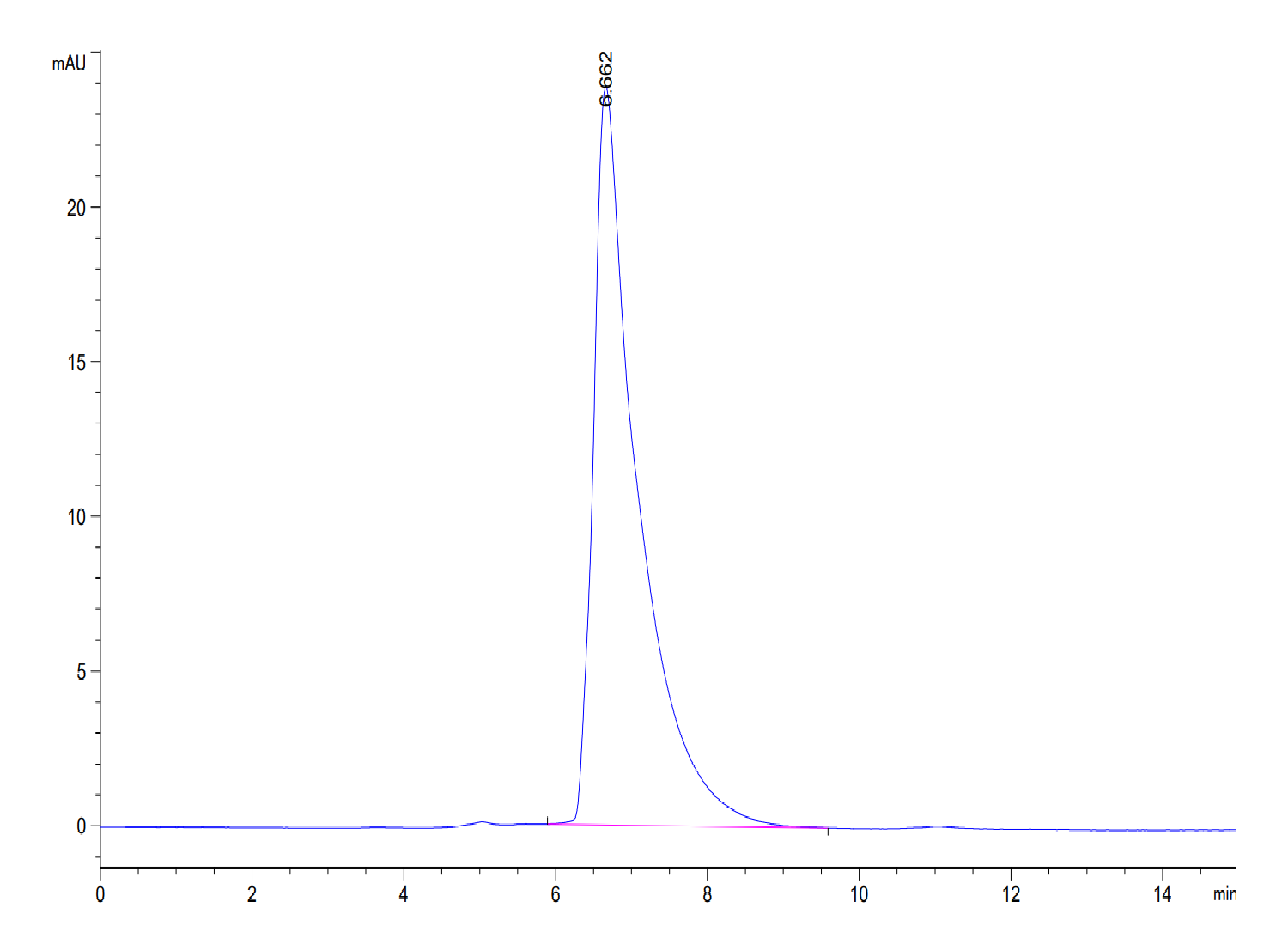| Weight | 1 lbs |
|---|---|
| Dimensions | 9 × 5 × 2 in |
| accession | Q8R5M8 |
| express system | HEK293 |
| product tag | C-His |
| purity | > 95% as determined by Tris-Bis PAGE;> 95% as determined by HPLC |
| background | The cell adhesion molecule 1 (CADM1) is a molecule of cell adhesion with multiple functions and has been identified as a tumor suppressor gene. CADM1 has multifunctions on the pathogenesis of malignancies, and other normal cells such as immune cells. On the contrary to these cutaneous solid tumors except for Merkel cell carcinoma, cutaneous lymphomas, such as adult-T cell leukemia/lymphoma, mycosis fungoides, and Sézary syndrome, increase their CADM1 expression for the development of tumor environment. |
| molecular weight | The protein has a predicted MW of 39.1 kDa. Due to glycosylation, the protein migrates to 75-80 kDa based on Tris-Bis PAGE result. |
| available size | 100 µg, 500 µg |
| endotoxin | Less than 1EU per μg by the LAL method. |
Mouse CADM1/IGSF4A Protein 3596
$240.00 – $800.00
Summary
- Expression: HEK293
- Pure: Yes (HPLC)
- Amino Acid Range: Gln48-Asp388
Mouse CADM1/IGSF4A Protein 3596
| protein |
|---|
| Size and concentration 100, 500µg and lyophilized |
| Form Lyophilized |
| Storage Instructions Valid for 12 months from date of receipt when stored at -80°C. Recommend to aliquot the protein into smaller quantities for optimal storage. Please minimize freeze-thaw cycles. |
| Storage buffer Shipped at ambient temperature. |
| Purity > 95% as determined by Tris-Bis PAGE |
| target relevance |
|---|
| The cell adhesion molecule 1 (CADM1) is a molecule of cell adhesion with multiple functions and has been identified as a tumor suppressor gene. CADM1 has multifunctions on the pathogenesis of malignancies, and other normal cells such as immune cells. On the contrary to these cutaneous solid tumors except for Merkel cell carcinoma, cutaneous lymphomas, such as adult-T cell leukemia/lymphoma, mycosis fungoides, and Sézary syndrome, increase their CADM1 expression for the development of tumor environment. |
| Protein names Cell adhesion molecule 1 (Immunoglobulin superfamily member 4) (IgSF4) (Nectin-like protein 2) (NECL-2) (Spermatogenic immunoglobulin superfamily) (SgIgSF) (Synaptic cell adhesion molecule) (SynCAM) (Tumor suppressor in lung cancer 1) (TSLC-1) |
| Gene names Cadm1,Cadm1 Igsf4 Necl2 Ra175 Syncam SynCam1 Tslc1 |
| Protein family Nectin family |
| Mass 10090Da |
| Function Mediates homophilic cell-cell adhesion in a Ca(2+)-independent manner (PubMed:12202822, PubMed:12799182, PubMed:12826663). Also mediates heterophilic cell-cell adhesion with CADM3 and NECTIN3 in a Ca(2+)-independent manner (PubMed:12826663). Interaction with CRTAM promotes natural killer (NK) cell cytotoxicity and interferon-gamma (IFN-gamma) secretion by CD8+ T-cells in vitro as well as NK cell-mediated rejection of tumors expressing CADM1 in vivo (PubMed:15811952). In mast cells, may mediate attachment to and promote communication with nerves (By similarity). CADM1, together with MITF, is essential for development and survival of mast cells in vivo (PubMed:15158462, PubMed:16605125). By interacting with CRTAM and thus promoting the adhesion between CD8+ T-cells and CD8+ dendritic cells, regulates the retention of activated CD8+ T-cell within the draining lymph node (PubMed:19752223). Required for the intestinal retention of intraepithelial CD4+ CD8+ T-cells and, to a lesser extent, intraepithelial and lamina propria CD8+ T-cells and CD4+ T-cells (PubMed:24687959). Interaction with CRTAM promotes the adhesion to gut-associated CD103+ dendritic cells, which may facilitate the expression of gut-homing and adhesion molecules on T-cells and the conversion of CD4+ T-cells into CD4+ CD8+ T-cells (PubMed:24687959). Acts as a synaptic cell adhesion molecule and plays a role in the formation of dendritic spines and in synapse assembly (PubMed:12202822, PubMed:23209303). May be involved in neuronal migration, axon growth, pathfinding, and fasciculation on the axons of differentiating neurons (PubMed:15707673). May play diverse roles in the spermatogenesis including in the adhesion of spermatocytes and spermatids to Sertoli cells and for their normal differentiation into mature spermatozoa (PubMed:12606335, PubMed:16612000). |
| Catalytic activity #N/A |
| Subellular location Cell membrane ; Single-pass type I membrane protein. Synaptic cell membrane ; Single-pass type I membrane protein. Note=Localized to the basolateral plasma membrane of epithelial cells in gall bladder. |
| Tissues Expressed dominantly in epithelial cells but not expressed in fibroblast cells (at protein level) (PubMed:12826663). Expressed in the T-cell area of lymph nodes, specifically in CD8+ and CD4- CD8- dendritic cells (at protein level) (PubMed:19752223). Expressed in CD8+ dendritic cells in the spleen (at protein level) (PubMed:19752223). Expressed in CD103+ dendritic cells in the small intestine lamina propria and mesenteric lymph nodes (at protein level) (PubMed:24687959). Expressed in brain, lung, kidney, testis, heart, spleen and liver, but not expressed in skeletal muscle (PubMed:12202822, PubMed:12242005, PubMed:12606335). |
| Structure Homodimer (via Ig-like V-type domain) (By similarity). Interacts with FARP1 (PubMed:23209303). Interacts (via Ig-like V-type domain) with CRTAM (via Ig-like V-type domain); the interaction competes with CRTAM homodimerization and CADM1 homodimerization (PubMed:15781451, PubMed:15811952). Interacts (via C-terminus) with EPB41L3/DAL1 (By similarity). The interaction with EPB41L3/DAL1 may act to anchor CADM1 to the actin cytoskeleton (By similarity). Interacts (via C-terminus) with MPP2 (via PDZ domain) (By similarity). Interacts (via C-terminus) with MPP3 (via PDZ domain); this interaction connects CADM1 with DLG1 (By similarity). Interacts (via C-terminus) with PALS2 (via PDZ domain) (PubMed:12826663). |
| Post-translational modification N-glycosylated.; Glycosylation at Asn-70 and Asn-104 promotes adhesive binding and synapse induction. |
| Domain Th |
| Target Relevance information above includes information from UniProt accession: Q8R5M8 |
| The UniProt Consortium |
Data
 |
| The purity of Mouse CADM1/IGSF4A is greater than 95% as determined by SEC-HPLC. |
 |
| Mouse CADM1/IGSF4A on Tris-Bis PAGE under reduced condition. The purity is greater than 95%. |
Publications
Publications
| pmid | title | authors | citation |
|---|---|---|---|
| We haven't added any publications to our database yet. | |||
Protocols
| relevant to this product |
|---|
Documents
| # | ||
|---|---|---|
| Please enter your product and batch number here to retrieve product datasheet, SDS, and QC information. | ||














